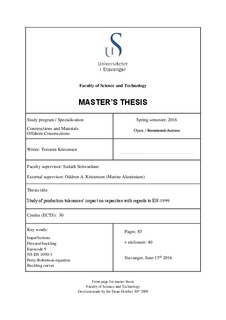| dc.contributor.author | Kristensen, Torstein | |
| dc.date.accessioned | 2016-09-28T12:22:26Z | |
| dc.date.available | 2016-09-28T12:22:26Z | |
| dc.date.issued | 2016-06-14 | |
| dc.identifier.uri | http://hdl.handle.net/11250/2411412 | |
| dc.description | Master's thesis in Offshore structural engineering | nb_NO |
| dc.description.abstract | The goal of this thesis was to investigate the effect that production tolerances has on the strength capacities of a beam or column. The out-of-straightness imperfection on a pinned column, and its effect on the flexural buckling resistance, was chosen as the main consideration. The production standard NS-EN 1090-3 has different production tolerances that must be followed if a beam or column is going to be approved according to Eurocode 9. This includes a tolerance limit for the out-of-straightness imperfection. This tolerance limit was investigated in order to determine if it was safe to follow. Imperfections in the cross-section geometry, and its respective tolerance limits, was also considered in this thesis.
The effect of the out-of-straightness imperfection was investigated using the Perry-Robertson formula. This Perry-Robertson method is in part used to develop the buckling curves that are presented in both Eurocode 3 and Eurocode 9 today. However, these buckling curves have been strengthen by tests results and experiments. As a simplified method, the Perry-Robertson formula can therefore not offer a perfect representation of the actual buckling behavior of an imperfect column, but it can be used to illustrate the effect of an out-of-straightness imperfection rather well. Several Perry-Robertson calculations were performed for different cross-section types and for different imperfection values. The results from these calculations showed a large drop in flexural buckling resistance for an imperfect column compared with a perfectly straight column. The loss in load carrying capacity also grew with larger imperfections. It was shown that cross-sections, which has a low resistance to buckling, was effected more severely by the imperfection. The production tolerance for an out-of-straightness imperfection, as given in NS-EN 1090-3, was compared with these calculations. With this comparison, it was found that trusting the tolerance limit might prove dangerous in some situations. An ANSYS finite element analysis was carried at Marine Aluminium for multiple columns with an imperfection of 10 mm, in order to verify the Perry-Robertson calculations. The results from this analysis indicated that the Perry-Robertson method was conservative, but that it simulated the effect of the imperfection well.
The same column-models was then used in Eurocode 9 capacity calculations. The Eurocode 9 guidelines for flexural buckling resistance has an imperfection safety factor that is used in all buckling calculations. The results from these calculations yielded a lower flexural buckling resistance than the Perry-Robertson method for all the columns that were tested. The Eurocode 9 calculations proved to be conservative enough that no dangerous situation was found while staying true to the tolerance limits given in NS-EN 1090-3. An argument that the imperfection safety factor is too conservative in some situations is made and the optimization of Eurocode 9 buckling calculations is discussed. | nb_NO |
| dc.language.iso | eng | nb_NO |
| dc.publisher | University of Stavanger, Norway | nb_NO |
| dc.relation.ispartofseries | Masteroppgave/UIS-TN-IKM/2016; | |
| dc.rights | Navngivelse 3.0 Norge | * |
| dc.rights.uri | http://creativecommons.org/licenses/by/3.0/no/ | * |
| dc.subject | imperfections | nb_NO |
| dc.subject | eurocode 9 | nb_NO |
| dc.subject | flexural buckling | nb_NO |
| dc.subject | offshore teknologi | nb_NO |
| dc.subject | konstruksjonsteknikk | nb_NO |
| dc.subject | offshorekonstruksjoner | nb_NO |
| dc.title | Study of production tolerances' effect on capacities with regards to EN-1999 | nb_NO |
| dc.type | Master thesis | nb_NO |
| dc.subject.nsi | VDP::Technology: 500::Marine technology: 580::Offshore technology: 581 | nb_NO |

